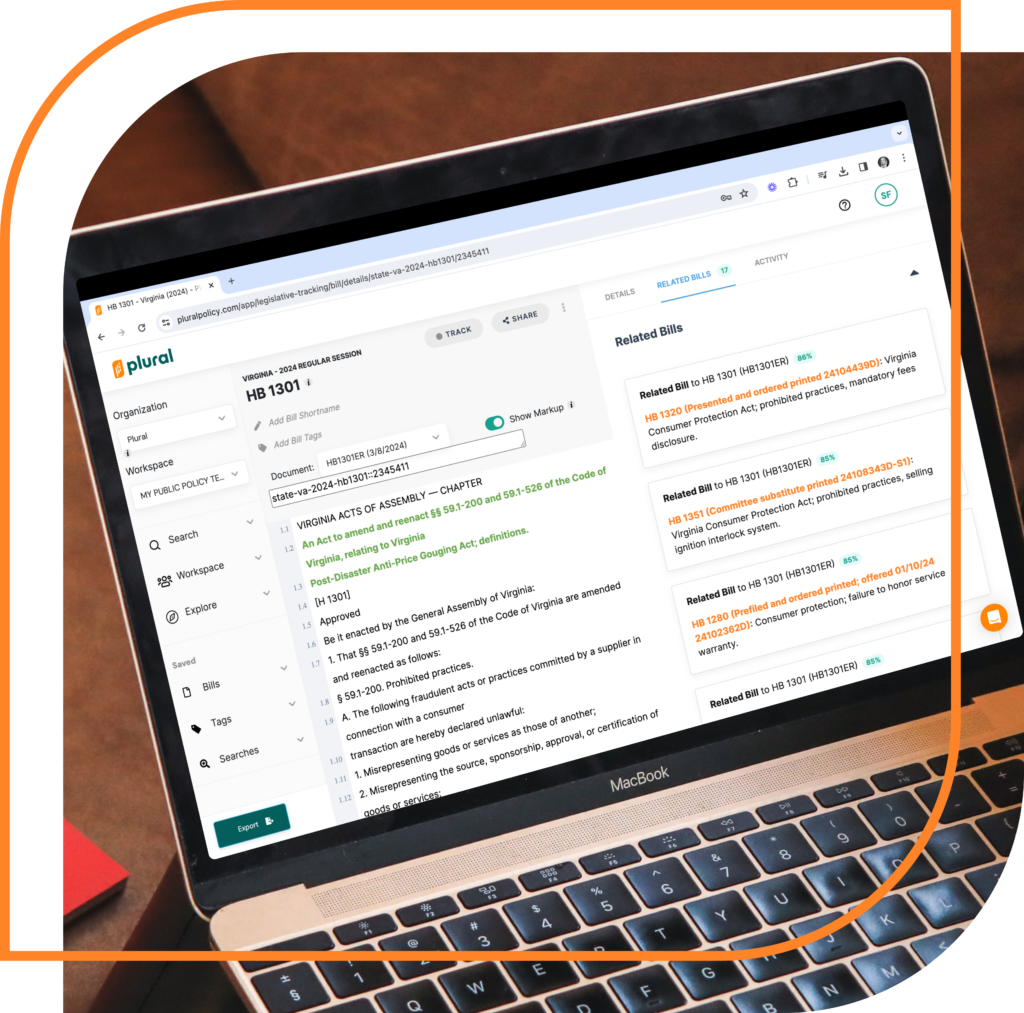Legislative proceedings are complex and often difficult to comprehend. However, the challenge doesn’t stop at policy analysis and identifying key legislation. It extends to uncovering the network of related bills, which may impact or influence your primary areas of interest. Understanding not just individual bills, but also their connections, is vital for policy pros. Plural’s “Related Bills” feature is an indispensable tool for successful policy professionals.
The Complexity of Legislative Analysis
Imagine a puzzle where each piece is a bill. Focusing on a single piece, or a single bill, can provide helpful insights. However, understanding how it connects to others builds a more comprehensive picture. This holistic view of policymaking is crucial. Yet, manually mapping these connections is a daunting, time-consuming task.
Related Bills: Your Legislative Compass for Policy Analysis
Plural’s Related Bills feature is designed to simplify this process. Plural automatically identifies and linking related legislation using AI. Related bills go beyond illuminating the legislative landscape. They also reveal strategic insights that could otherwise be missed.
How It Works
Calculating Text Similarity
Related Bill recommendations are based on the degree of text similarity between bills. Plural calculates text similarity at a sentence level. First, it removes from its analysis any “boilerplate” language that is used in most bills. It then breaks down each version of a bill into its component sentences, comparing them to versions of other bills. When two bills share at least 65% of the same substantive sentences, Plural identifies them as related.

Labeling Relationships
Once Plural finds bills that are related, it labels the relationship. Currently, Plural is labeling the following kinds of relationships:
- Companion Bills. Similar or identical legislation that are introduced in the upper and lower chambers of a legislature during the same session.
- Re-Introduced Bills. Bills that do not make it through the legislative process by the end of a session are often re-introduced in a later session.
- Omnibus Bills. Omnibus bills consolidate various other bills — that often span a number of issues — into a single package. Plural identifies when a smaller bill has been pulled into a larger omnibus bill, and vice versa.
Where to Find It
Find related bills in the “Related Bills” tab of a Bill Detail page. If Plural has identified one or more related bills, you will also see an alert icon displayed to the right of the tab.
Benefits Unpacked
Strategic Advantage
Discover potential allies or oppositions through related bills, enabling more informed strategy development.
Efficiency in Research
Save hours by instantly accessing a curated list of related legislation, rather than manually compiling connections.
Depth of Understanding
Gain deeper insights into the legislative ecosystem. This includes how various bills interlink and affect each other.
Get Started With Plural
Don’t let vital connections slip through the cracks in your policy analysis. Sign up for a demo of Plural today, and unlock the full potential of the Related Bills feature. Empower your legislative strategy with comprehensive insights and a more profound understanding of bill relationships.
Have you leveraged Related Bills to achieve legislative success? We’re eager to hear how this tool has transformed your approach to policy work. Share your experiences and help inspire others to navigate the legislative web more effectively. Reach out to support@pluralpolicy.com to share your experience.
More Resources for Public Policy Teams
Key Benefits of AI for Lobbying & Advocacy
Want to be able to explain the benefits of artificial intelligence for lobbying and advocacy? Everyone is talking about AI. And we get it, it’s not simple to understand. But as an AI-powered organization, Plural is here to help you get the most out of advancements in AI to make your job as a policy […]
2025 Legislative Committee Deadlines Calendar
Staying on top of key deadlines is manageable in one state, but if you’re tracking bills across multiple states, or nationwide, it quickly becomes overwhelming. That’s why we created the 2025 Legislative Committee Deadlines Calendar. Stay ahead of important dates and download our calendar today. Get started with Plural. Plural helps top public policy teams get […]
End of Session Report: Florida 2024 Legislative Session
The 2024 Florida legislative session saw significant activity in the realm of insurance and financial services, reflecting key themes of consumer protection, market stability, and regulatory modernization.




